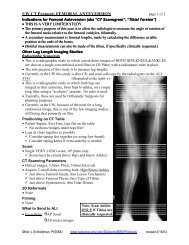Ankle and Foot 47 - Department of Radiology - University of ...
Ankle and Foot 47 - Department of Radiology - University of ...
Ankle and Foot 47 - Department of Radiology - University of ...
You also want an ePaper? Increase the reach of your titles
YUMPU automatically turns print PDFs into web optimized ePapers that Google loves.
2252 VII Imaging <strong>of</strong> the Musculoskeletal System<br />
A<br />
B<br />
Figure <strong>47</strong>-60. Weber injuries. Structures are as<br />
identified in Figure <strong>47</strong>-59. A, Weber type A. Left,<br />
Anteroposterior radiograph <strong>of</strong> the ankle showing<br />
medial displacement <strong>of</strong> the talus relative to the tibia, a<br />
horizontal avulsion fracture through the lateral<br />
malleolus, <strong>and</strong> a vertically oriented compression<br />
fracture through the medial malleolus. Right,<br />
Schematic showing the mechanism <strong>of</strong> a Weber type A<br />
ankle fracture. As the talus undergoes an inversion<br />
rotational injury, it applies avulsive pulling forces on<br />
the lateral side <strong>of</strong> the mortise <strong>and</strong> compressive<br />
pushing forces on the medial side. B, Weber type B.<br />
Left, Anteroposterior radiograph <strong>of</strong> the ankle showing<br />
lateral displacement <strong>of</strong> the talus relative to the tibia, a<br />
horizontal avulsion fracture through the medial<br />
malleolus, <strong>and</strong> an obliquely vertically oriented<br />
compression fracture through the distal fibular, below<br />
the level <strong>of</strong> the syndesmosis. Right, Schematic showing<br />
the mechanism <strong>of</strong> a Weber type B ankle fracture. As<br />
the talus undergoes an eversion rotational injury, it<br />
applies avulsive pulling forces on the medial<br />
malleolus <strong>and</strong> compressive pushing forces on the<br />
fibula. C, Weber type C. Left, Anteroposterior<br />
radiograph <strong>of</strong> the ankle showing a horizontal avulsion<br />
fracture through the medial malleolus <strong>and</strong> an<br />
obliquely vertically oriented compression fracture<br />
through the distal fibular, above the level <strong>of</strong> the<br />
syndesmosis. The syndesmosis is disrupted <strong>and</strong><br />
abnormally widened, with no overlap between the<br />
tibia <strong>and</strong> fibula. Right, Schematic showing the<br />
mechanism <strong>of</strong> a Weber type C ankle fracture. This is<br />
the same as a Weber type B, except now the<br />
compressive forces extend through the syndesmosis,<br />
tearing the tibi<strong>of</strong>ibular ligaments <strong>and</strong> the distal<br />
intraosseous membrane (IOM), with the oblique<br />
fracture higher up on the fibula. (If the compressive<br />
forces extend proximally up the length <strong>of</strong> the IOM,<br />
fracturing through the proximal fibula up near the<br />
knee, this is referred to as a Maisonneuve fracture<br />
[not illustrated].)<br />
C<br />
Ch0<strong>47</strong>-A05375.indd 2252<br />
9/9/2008 5:34:45 PM
















